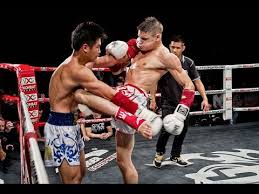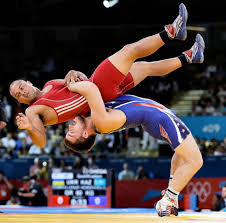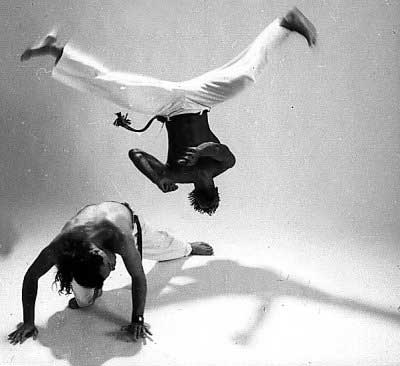THAI BOXING
 THAI BOXING (Muay Thai), the martial art of Thailand. One of the meanings of the word “thai” is free, therefore the name of this martial art can also be translated as “free battle”. Fights in Thai boxing are in full contact according to very strict rules. Muay Thai is based on percussion technique. Blows are applied at all levels: to the head and to the body, arms and legs, elbows and knees. Grips and throws play a secondary role. Applied equipment is also cultivated in Muay Thai: work with pricking and cutting weapons, various types of daggers, sticks, throwing knives, etc. The Thai government is committed to promoting the development of Muay Thai and allocates considerable funds for this. Currently, Thai fighting is popular far beyond the borders of the country.
THAI BOXING (Muay Thai), the martial art of Thailand. One of the meanings of the word “thai” is free, therefore the name of this martial art can also be translated as “free battle”. Fights in Thai boxing are in full contact according to very strict rules. Muay Thai is based on percussion technique. Blows are applied at all levels: to the head and to the body, arms and legs, elbows and knees. Grips and throws play a secondary role. Applied equipment is also cultivated in Muay Thai: work with pricking and cutting weapons, various types of daggers, sticks, throwing knives, etc. The Thai government is committed to promoting the development of Muay Thai and allocates considerable funds for this. Currently, Thai fighting is popular far beyond the borders of the country.
HISTORY REFERENCE.
Already in the 13th century. in the territory of modern Thailand there was the art of fighting with bare hands and feet – may si juice. Later, with the formation of the state of Ayutthaya (Siam), a new martial art appeared – plowing (lit. “multilateral battle”), which over time also became known as “Muay Thai”. Muay Thai is widespread in Ayutthaya. Outstanding fighters were enrolled in the royal guard and assigned them the noble title. Muay Thai princes of blood and aristocrats without fail studied. For a long time he developed as a system of tough hand-to-hand combat. A warrior who mastered the techniques of Muay Thai could successfully continue the battle, even having lost his weapon.
The legendary warrior Nai Khan Tom is considered the “patron” of Thai boxing. During the war with Burma in 1774 he was captured. The Burmese had their own martial art – Parma. The Burmese King Mangra decided to arrange a duel between Thai boxers and Parma masters to find out which art is stronger. Nai Kham Tom alone fought in turn with ten Burmese masters without interruption. Having won all ten fights, he received freedom and returned home as a national hero. Until now, “Boxing Night” is celebrated annually in Thailand on March 17th: fights are held across the country in honor of the legendary warrior.
In 1788, representatives of Muay Thai first met in the ring with the Europeans. Two masters of French boxing, traveling around Thailand, asked the Thai king for permission to fight with local fighters. The chief instructor of the Ministry of Defense of Thailand, master Muen Plan, accepted the challenge and defeated both rivals.
Thailand took part in the First World War on the side of the Entente. It was at this time that information about Thai boxing began to penetrate widely into Europe. The poorly armed Thais made a great impression on the European allies with their physical training and excellent hand-to-hand fighting skills.
In 1921, during the reign of King Rama VI, Muay Thai began to develop as a sport. General Praia Nonsen Surendra Pandy, on behalf of the king, organized a Muay Thai study center on the territory of one of Bangkok’s colleges. In 1929, “modernized” rules were adopted. (Muay Thai is still considered one of the toughest martial arts, and in those days, the death or severe injuries of a fighter during a duel were commonplace.) The ground platforms were replaced with a ring measuring 6ґ6 meters, fenced with ropes. The time of the fight was limited to 5 rounds of 3 minutes with minute breaks (before the fight lasted until one of the opponents lost the ability to continue the fight). Instead of the traditional leather belts with which the soldiers bandaged their hands, boxing gloves were introduced. Leg protection was not provided, but the rules allowed bandaging the lower leg and raising the foot. 7 weight categories were introduced (before division into weight categories in Muay Thai did not exist).
In the mid-1960s, a genuine boom in Thai boxing began in Europe and the USA. It was then that representatives of Muay Thai suggested that representatives of other martial arts fight with them. The challenge was accepted by the Kekushinkai Karate master. The historic match took place on February 17, 1966 in Bangkok. 3 athletes participated on each side. The match ended with a score 2: 1 in favor of the Kekushinkai Karate masters. Nevertheless, they appreciated Muay Thai and adopted some of its elements.
The International Amateur Thai Boxing Federation (IAMTF) was created in 1984. Today it includes regional organizations in more than 70 countries, this is the largest of the amateur associations of Muay Thai. At the same time, organizations conducting professional battles are operating. With the growing popularity of Muay Thai around the world, many professional kickboxing leagues have switched to Thai boxing and its European variation, thai kickboxing.
Seven-time world champion in full contact and famous actor Chuck Norris calls Muay Thai “21st Century Sports.” Steps are being taken to recognize him as an Olympic sport.




